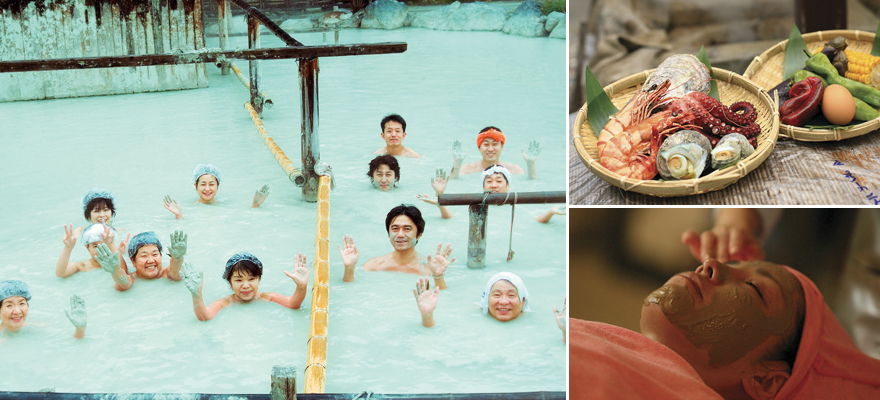Home > Highlighting JAPAN > Highlighting Japan August 2013 > Onpaku
Highlighting JAPAN
Livable Cities
Onpaku
A recipe for revitalization

Japan loves word contractions. We have konbini (convenience store), sumafo (smart phone), and even arafo (around 40 years old). But a new one for us recently has been Onpaku, which expands out to “onsen hakurankai” that in English means to stay at an onsen. But Onpaku is more than just a contraction. The concept goes deep and implies that a stay at an onsen town can be a unique opportunity to experience and appreciate traditional Japan.
The Onpaku movement was born in Beppu, Oita-ken, in 2001, out of concern that the local economy was suffering from falling numbers of holiday makers and their all-too transient attitude. Much like Europe has slow food, the Onpaku founders wanted to imbue their visitors with the sense of depth of hospitality and tradition that gives guests an added flavor to their stay. Sometimes it might be a special performance by local artists and other times a memorable personal experience with a craftsperson.
The objective of the Onpaku program is to create a uniformly high-level consumer experience in rural communities that finicky town-dwelling customers love. The consistency of service, the desirability of old customs and traditions laid out in an interesting way, and professional marketing all mean that consumers join an Onpaku event in a totally different light. This means that formerly commonplace experiences can be elevated to something special, and that consumers are willing to pay more to get access to authentic experiences they have lost touch with in their busy modern lives.
As a result, Onpaku has spread far beyond the original group’s imaginings more than a decade after being conceived. Not only does it include more than 100 different travel experiences, ranging from zazen lessons at local Buddhist temples to pottery lessons, but the program has also blossomed across Japan. There are 18 other towns in the Onpaku program, with more on the way.
Of the many traditional Onpaku tours on offer in Beppu, one of the more popular is pottery classes in a craft-shop on the outskirts of the city since, apart from hotsprings, Oita-ken is also very well known for its pottery craftwork. The experience includes a chance to learn how to use clay, equipment and kilns in order to make one’s own pottery art. This is followed by a washoku lunch made from spring vegetables grown in the local garden.
The early years of Onpaku were filled with experiments and learning, which eventually led to a proven methodology that makes the program exportable and replicable. Indeed, the power of the program means that new towns joining Onpaku can experience startling transformations, as their leaders and merchants start to practice the concept and the discipline that comes with it. The Nippon Foundation and the Ministry of Economy, Trade and Industry initially gave impetus to the program, which led to predictability and a well-developed structure in its implementation.
So what is the Onpaku program?
Basically there are five parts, all designed to integrate and create richer, more rewarding experiences for the public.
The first step of the “Onpaku method” – Awareness – involves creating a secretariat for the town, which coordinates all aspects of education and training of the participants, as well as marketing efforts. Having a secretariat means that all the key decision makers in the community collaborate on the concept to make it successful.
The second step, Social Preparation, involves developing the right environment for cooperation. This includes training and study groups to develop the program’s core resources—people—as well as the development of services and finances. Trainers from Beppu are dispatched to the candidate town, to ensure that the program is properly understood.
The third step, Roll-out Preparation, finds trainers taking on a consultative approach and areas for improvement. The trainers then proceed to fill those gaps. It is also around this time that the new secretariat starts producing its marketing materials and gets down to operational issues such as scheduling and specifics.
The fourth step is Roll-out. This stage involves the actual offering of the tours and exeriences, including a rigorous checking-scheme to ensure that tours meet high standards. If there is going to be a point of failure for a candidate township, it will be in this phase, and solidarity is essential in overcoming the challenges and disappointments along the way.
The final step is Review and Refinement. The team must have proven that they had the mettle to succeed and are not simply content to rest on their laurels. Visitors can be a fickle bunch who, without continuous improvement, will soon find other places to go.
The Onpaku organizers have learned many new things. As communities that used to compete with each other for tourists now learn to collaborate under a central set of guidelines, a surprising thing happens: the tourists start coming back. Satisfied visitors then tell their friends about the traditional Japan they re-discovered and soon the economic benefits follow. This is a healthy recipe for revitalizing traditional Japan.
© 2009 Cabinet Office, Government of Japan






